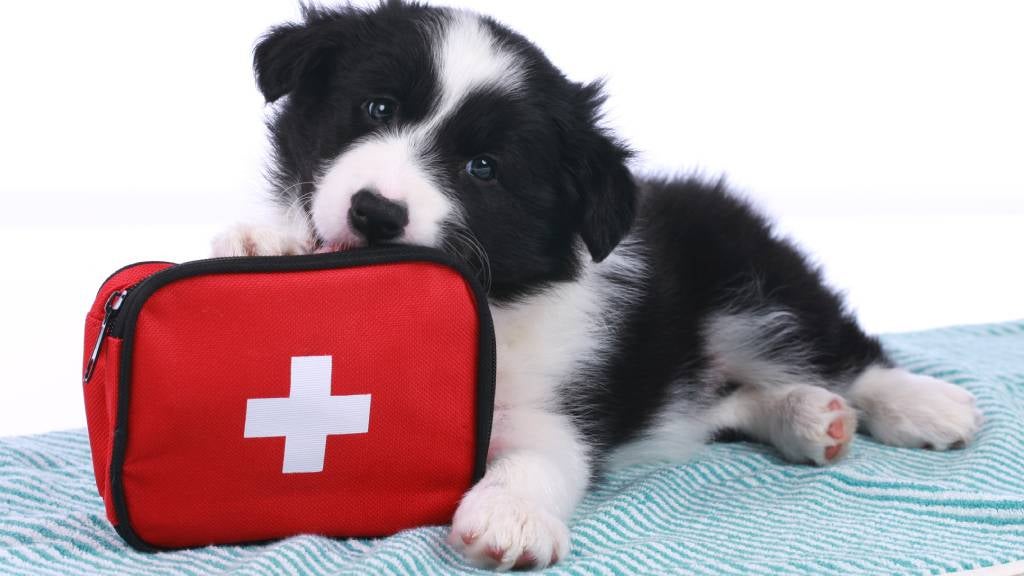Quick take
- A calm plan helps you act fast when accidents happen
- Basic CPR knowledge, wound care and safe transport can stabilise your dog until you reach a vet
- Never give human medicines unless a vet tells you to
- Build and maintain a dog first aid kit – check it every 3–6 months
- When in doubt, call a vet – prompt advice can be lifesaving
Why every dog owner needs first aid knowledge
Emergencies can happen anywhere – from the backyard to the beach. Knowing simple first aid can steady the situation, reduce stress and buy time on the way to professional care. Even minor injuries need prompt attention, while serious issues like choking, heat stress or suspected poisoning require immediate action.
Essential first aid tips
1. Know CPR for dogs
If your dog is unresponsive and not breathing, performing CPR may help while you arrange urgent veterinary care.
- Lay your dog on their right side on a firm surface
- Check for normal breathing and a heartbeat
- If absent, begin chest compressions at a steady rhythm – about one third to half chest depth
- Give occasional rescue breaths if trained and it is safe to do so
- Continue until your dog breathes or moves, or until a vet takes over
2. Treating wounds and bleeding
- Apply firm, direct pressure with a clean cloth or bandage
- Elevate the area if possible and safe
- Do not use human antiseptics unless a vet has advised it
- Seek veterinary care for deep cuts, punctures or heavy bleeding
3. Choking or obstruction
- Check the mouth: Look for visible objects and gently try to remove them if safe
- Don’t reach deep: Avoid putting fingers far into the throat – it can make things worse
- No forceful techniques: Back blows or abdominal thrusts should only be done by trained professionals
- Go to the vet: If your pet can’t breathe or the object won’t come out, seek urgent veterinary care
- Aftercare matters: Even if the object is removed, a vet check is important
4. Heatstroke prevention and response
- Move to shade or a cool area, offer small amounts of water
- Wet the coat with cool – not icy – water and use airflow if possible
- Seek veterinary attention immediately if your dog shows weakness, collapse, vomiting or confusion
5. Poisoning and toxins
- Keep chocolate, grapes and raisins, other dangerous food items as well as household chemicals and medicines well out of reach
- If ingestion occurs, call a vet immediately – do not induce vomiting unless told to
- Watch for signs like drooling, vomiting, tremors or seizures and seek urgent help
6. Snake bites
- Keep your dog calm and as still as possible if they are bitten by a snake – carry them if you can
- If the bite is on a limb and you are trained, apply a firm pressure bandage starting at the paw and working up the limb – never use a tourniquet
- Do not wash, cut or suck the wound – avoid ice or electric shock
- Seek emergency veterinary care immediately – call ahead so the clinic can prepare
- If it’s safe, note the snake’s colour and size for the vet – never try to capture or kill the snake
Building a dog first aid kit
Pack these basics and store them in an easy-to-grab container:
- Sterile gauze pads and rolls, adhesive tape and cohesive vet wrap
- Saline pods, cotton pads, antiseptic suitable for pets
- Scissors, tweezers and disposable gloves
- Digital thermometer and lubricant
- Soft muzzle or bandage material to improvise one – for safety when a dog is in pain
- Emergency contacts – your vet and the nearest 24-hour clinic
- Clean towels or a light blanket for warmth and transport
Training and preparedness
- Take a pet first aid course to build confidence and practise skills
- Check kit contents every 3–6 months and replace expired items
- Keep a simple emergency plan – who drives, which clinic, how to lift and secure your dog
- Note your dog’s medications, allergies and any chronic conditions
Final thoughts
First aid is about calm, simple actions that keep your dog as safe as possible until a vet takes over. With some prep, a stocked kit and a clear plan, you’ll be ready to help when your best mate needs you most.
Keep your emergency plan pet-ready with Buddy
From everyday mishaps to unexpected scares, having a plan makes all the difference. Buddy Pet Insurance can help you feel confident that you are prepared for any unforeseen incidents. That way, you can focus on care and comfort – not the what-ifs.
FAQsFrequently Asked Questions about dog first aid
What should be in a dog first aid kit?
Gauze, bandages, pet-safe antiseptic, saline pods, scissors, tweezers, gloves, a thermometer, a soft muzzle and emergency vet contacts are solid basics.
Can I give my dog human painkillers?
No – many human medications are unsafe for dogs. Speak to a vet before giving any medicine.
How do I know if it’s an emergency?
If your dog collapses, has breathing trouble, uncontrolled bleeding, seizures, suspected poisoning or major trauma will all need urgent veterinary care.
Should I learn pet CPR?
Yes – a reputable course such as Australian Red Cross builds skills and confidence so you can act while heading to a vet.
Is it safe to induce vomiting after poisoning?
Only if a vet has advised it – some substances cause more harm if vomited. Call a vet immediately for instructions.
21 Nov 2025

